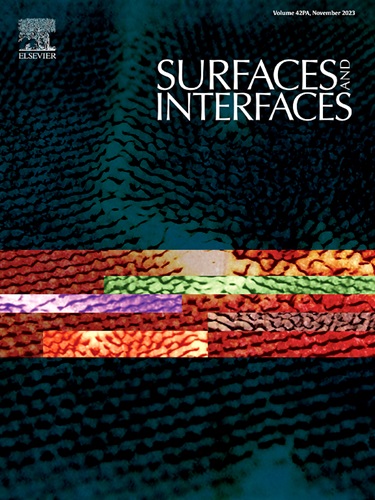激光工程亚稳α-Fe2O3纳米点具有显著的过氧化物酶样催化活性葡萄糖传感
IF 5.7
2区 材料科学
Q2 CHEMISTRY, PHYSICAL
引用次数: 0
摘要
自从发现Fe3O4具有内在的类酶催化活性以来,铁基氧化物一直是纳米酶研究的热点。然而,尽管α-Fe2O3具有相当大的工业潜力和广泛的应用,但由于其相对较低的类酶催化效率而受到有限的关注。在这项工作中,我们提出了一种创新的激光加工技术合成亚稳α-Fe2O3纳米点(M-Fe2O3 NDs)。亚稳结构的形成主要归因于激光诱导的高温碎裂和快速淬火。由于M-Fe2O3 nd具有较高的比表面积,较高的Fe2+/Fe3+比促进了表面Fe2+的快速再生,以及弱晶结构对H2O2的强亲和力,因此具有显著的过氧化物酶活性。M-Fe2O3纳米粒子的催化效率比激光处理前的α-Fe2O3纳米粒子高17,438倍,比同等尺寸的Fe3O4纳米粒子高87倍。此外,我们还通过将M-Fe2O3 nd与葡萄糖氧化酶集成开发了一种高灵敏度的葡萄糖传感器。这一进展为设计更高效的铁基氧化酶纳米酶和增强葡萄糖传感器铺平了道路。本文章由计算机程序翻译,如有差异,请以英文原文为准。

Laser-engineered metastable α-Fe2O3 nanodots with remarkable peroxidase-like catalytic activity for glucose sensing
Iron-based oxides have been a focus point in the study of nanozymes since the discovery of the intrinsic enzyme-like catalytic activity of Fe3O4. However, α-Fe2O3 has received limited attention due to its relatively low enzyme-like catalytic efficiency, despite its considerable industrial potential and wide-ranging applications. In this work, we present the synthesis of metastable α-Fe2O3 nanodots (M-Fe2O3 NDs) using an innovative laser processing technique. The formation of the metastable structure is primarily attributed to laser-induced high temperature fragmentation and rapid quenching. M-Fe2O3 NDs exhibit remarkable peroxidase-like activity, attributed to their high specific surface area, the rapid regeneration of surface Fe2+ facilitated by the elevated Fe2+/Fe3+ ratio, and the strong affinity for H2O2 resulting from their weak-crystalline structure. The catalytic efficiency of M-Fe2O3 NDs was found to be 17,438 times higher than that of α-Fe2O3 nanoparticles before laser treatment and 87 times higher than that of Fe3O4 NDs of comparable size. Additionally, we have developed a highly sensitive glucose sensor by integrating M-Fe2O3 NDs with glucose oxidase. This development paves the way for the design of more efficient Fe-based oxidase nanozymes and the enhancement of glucose sensors.
求助全文
通过发布文献求助,成功后即可免费获取论文全文。
去求助
来源期刊

Surfaces and Interfaces
Chemistry-General Chemistry
CiteScore
8.50
自引率
6.50%
发文量
753
审稿时长
35 days
期刊介绍:
The aim of the journal is to provide a respectful outlet for ''sound science'' papers in all research areas on surfaces and interfaces. We define sound science papers as papers that describe new and well-executed research, but that do not necessarily provide brand new insights or are merely a description of research results.
Surfaces and Interfaces publishes research papers in all fields of surface science which may not always find the right home on first submission to our Elsevier sister journals (Applied Surface, Surface and Coatings Technology, Thin Solid Films)
 求助内容:
求助内容: 应助结果提醒方式:
应助结果提醒方式:


